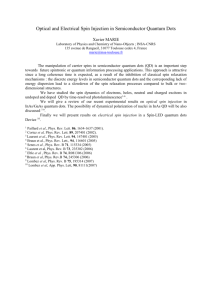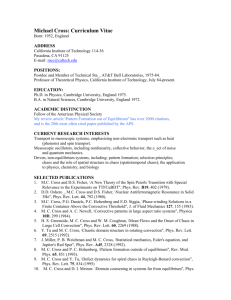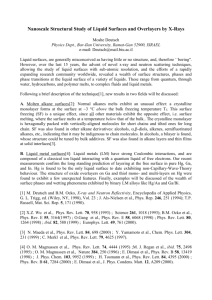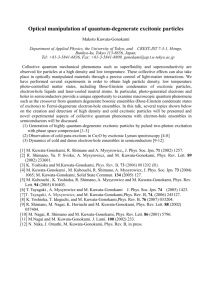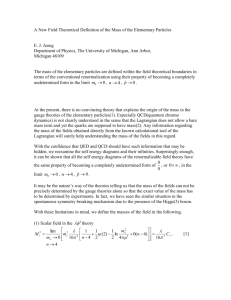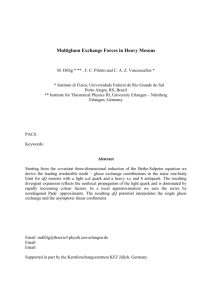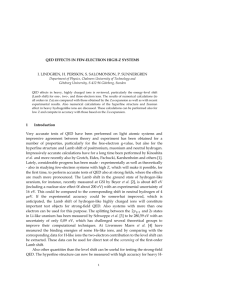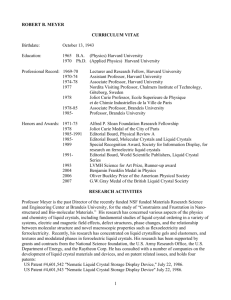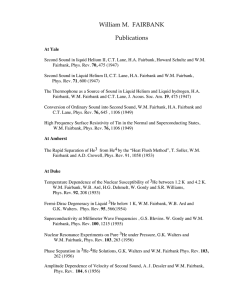Effective QCD, QED Potentials
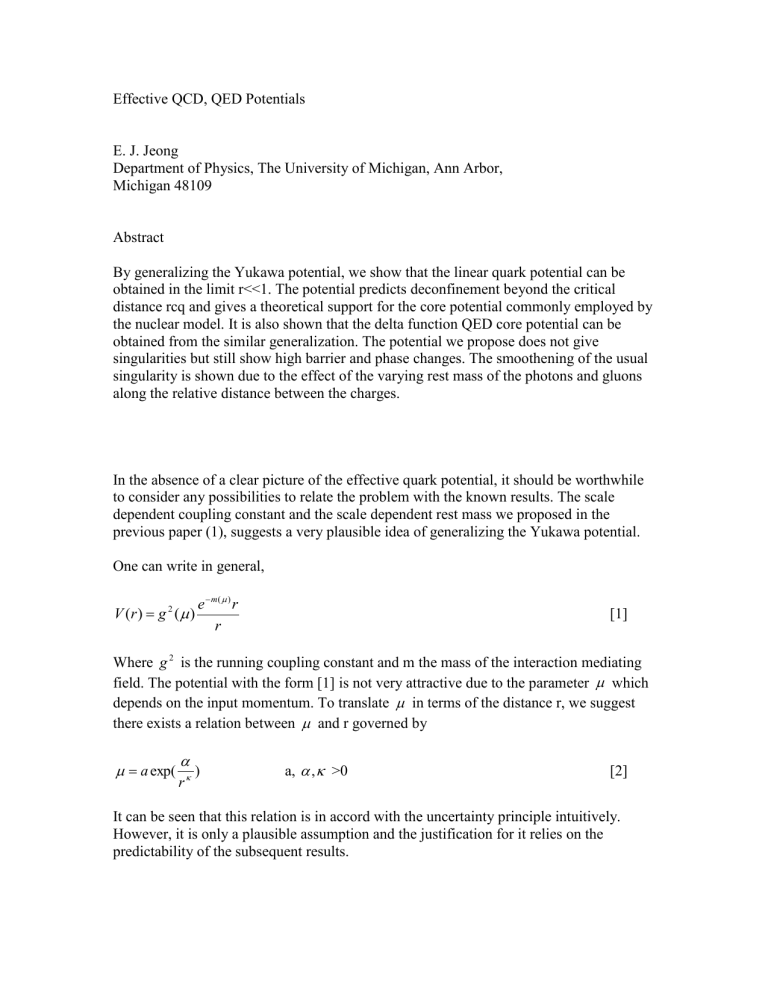
Effective QCD, QED Potentials
E. J. Jeong
Department of Physics, The University of Michigan, Ann Arbor,
Michigan 48109
Abstract
By generalizing the Yukawa potential, we show that the linear quark potential can be obtained in the limit r<<1. The potential predicts deconfinement beyond the critical distance rcq and gives a theoretical support for the core potential commonly employed by the nuclear model. It is also shown that the delta function QED core potential can be obtained from the similar generalization. The potential we propose does not give singularities but still show high barrier and phase changes. The smoothening of the usual singularity is shown due to the effect of the varying rest mass of the photons and gluons along the relative distance between the charges.
In the absence of a clear picture of the effective quark potential, it should be worthwhile to consider any possibilities to relate the problem with the known results. The scale dependent coupling constant and the scale dependent rest mass we proposed in the previous paper (1), suggests a very plausible idea of generalizing the Yukawa potential.
One can write in general,
V ( r )
g
2
(
) e
m (
) r r
[1]
Where
2 g is the running coupling constant and m the mass of the interaction mediating field. The potential with the form [1] is not very attractive due to the parameter
which depends on the input momentum. To translate
in terms of the distance r, we suggest there exists a relation between
and r governed by
a exp( r
) a,
,
>0 [2]
It can be seen that this relation is in accord with the uncertainty principle intuitively.
However, it is only a plausible assumption and the justification for it relies on the predictability of the subsequent results.
Using the detailed presentation by P. Ramond (2) on the scale dependent coupling constant which has been developed by many authors (3), and the scale dependent rest mass we proposed earlier, we write the effective quark potential,
V ( r )
1
g
0
2
2 g
8
0
2 ln
0
1
1 exp(
( r
8
1
2 g
0
2
C g
C k
2 g
8
0
2 ln
0
)
1 / 2 r ) [3] by substituting [2] into [3] and with
=2 for the moment, the potential has the form
V ( r )
A
1
B
1 exp(
( r
1
8
A
2 r
2
C k
C g
B
)
1 / 2 r ) [4] r
2
Where C g
is the gluon mass constant which is given by C g
= 5 .
8
10
103 g
2
using the upper limit of the photon rest mass 3
10
53 g (4) and C
is the group structure constant which has the order of magnitude 1.
For a small r, [4] can be approximated by
V ( r )
r
A
( 1
B
A r
2
......) [5]
The potential [4] has a peak at r
A
( 1
B
3 A
2
C g
) and its magnitude
V peak
8
2
6 C g
B
1 / 2
A
5 / 2 exp(
B
1
6 A
) . [6]
At r
r cq
A
, the potential is damped to zero by the exponential term and becomes
B negative and imaginary as r becomes larger.
In quantum mechanics, the imaginary potential is known to violate the conservation of the probability.
Therefore, our effective quark potential has the following desired features.
1.
linear potential for small distances
2.
confinement at ordinary energy level
3.
deconfinement at extremely high energy level
4.
probability non-conservation beyond the critical distance
5.
theoretical support for the core potential commonly employed by the phenomenological nuclear potential model
6.
no singularity following the relative distance
The extension of this scheme to QED effective potential is straightforward and can be written,
V ( r )
1
C
D r
2
1 exp(
( r
1
6
2
C
C
D r
2
)
1 / 2 r ) , where C
is the photon mass constant (1).
[7]
For large r, the QED potential is reduced into the usual Coulomb potential. As the distance decreases toward
D
, the potential has a peak depth but not infinity. At
C r
r ce
D
, the potential shows a hard core rising up to the zero level and as r gets
C smaller, it rises above zero and becomes imaginary. It may not be too absurd to interpret this behavior of the potential as a suggestion of the annihilation when the two oppositely charged particles come close sufficiently together.
In fact, the sharply rising core potential has already been used in QED for the calculation of the “Lamb shift” (5) in the form of a
( r ) function.
Overall, the potentials are very attractive except that they have to be tested by the experimental results. The prediction of the quark deconfinement is interesting. However, the energy required to produce the deconfinement may be too high to be realized in the near future laboratory experiment.
By adding the two potentials [4] and [7] at the intermediary distances, we have
V ( r )
1
Cr r
A
[8]
This is the well known non-relativistic potential which has resulted in good agreement with the experiment in the heavy quarkonia spectroscopy (6).
It is an interesting conjecture that the finite barrier of the quark potential may produce some finite probability of finding fractional charges, which has been demonstrated by
Fairbank et al. (7) even though the quark itself has not been isolated.
We will discuss the various consequences of the results elsewhere.
References
(1)
E. J. Jeong “ A new definition of the mass of the fields”
(2) P. Ramond, Field Theory, A Modern Primer Benjamin Cummings pub./com. Inc.
(1980).
(3) M. Gell-Mann and F. Low, Phys. Rev. 95 (1954) 1300; E. Stueckelberg and A.
Petermann, Helv. Phys. Acta 5 (1953) 499; N. N. Bogoliubov and D. V. Shirkov,
Introduction to the theory of Quantized Fields ( Interscience, New York, 1959);
K. Wilson, Phys. Rev. D3 (1971) 1818; K. Wilson and J. Kogut, Phys. Reports 12
(1974) 75; K. Symanzik, Lett. Nuovo Cimento 6 (1973) 77; D. Gross and F.
Wilczek, Phys. Rev. Letters 26 (1973) 1343; H. D. Politzer, Phys. Rev. Letters 26
(1973) 1117.
(4) A. Barnes and J. Scargle, Phys. Rev. Lett. 35 (1975) 1117.
(5) Bjorken & Drell, Relativistic Quantum Mechanics, McGraw-Hill Inc. (1964).
(6) K. J. Miller and M. G. Olsson, Phys. Rev. 25D (1982) 2383; E. Eichten, K,
Gottfried, T. Kinoshita, J. Kogut, K. D. Lane and T. M. Yan, Phys. Rev. Lett. 34
(1975) 369; S. Jacobs and M. G. Olsson, Phys. Lett. 133B (1983) 111; E. Eichten,
K. Gottfried, T. Kinoshita, K. D. Lane and T. –M. Yan, Phys. Rev. 21D (1980)
203; V. A. Novikov et al., Phys. Reports 41C (1978) 16.
(7) G. S. LaRue, W. M. Fairbank and A. F. Hebard, Phys. Rev. Lett. 38 (1977) 1011;
G. S. LaRue, W. M. Fairbank, and A. F. Hebard, Phys. Rev. Lett. 42 (1972) 142;
L. J. Schaad and B. A. Hess, Jr., J. P. WIkswo, Jr., W. M. Fairbank, Phys. Rev.
23A (1981) 1600
